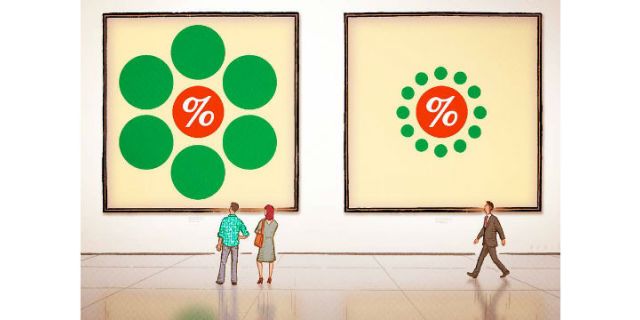Reblog: When a 10% gain makes you feel like a loser

Big gains can be hard to find in the financial markets. Nowadays, though, they seem to be everywhere — and that could change how you feel about taking risks.
As of Nov. 16, the S&P 500 is up 359% since the bull market began March 9, 2009, counting dividends, according to S&P Dow Jones Indices. This year alone through Nov. 16, Alphabet (the parent company of Google) has returned 32%, Amazon.com 52%, Apple 50% and Facebook 56%, including dividends. Bitcoin, the digital currency, has gained more than 700% so far this year.
Against that backdrop, even what investors used to regard as a generous annual gain — say, 10% — starts to feel paltry. New research into a mental process called “contrast effects” shows how that works and how it can alter your behavior.
Finance professors Samuel Hartzmark of the University of Chicago Booth School of Business and Kelly Shue of Yale University’s School of Management analyzed nearly 76,000 earnings announcements from 1984 through 2013 in which companies earned either more or less than investors were expecting.
In a positive earnings surprise, a company reports net income greater than the average forecast by Wall Street analysts; in a negative surprise, earnings fall short of that consensus.
The researchers found that when companies announced a positive surprise the day after a firm in the top tenth by market value also beat expectations, their shares didn’t go up nearly as much as they normally would. And the day after a big company announced a negative earnings surprise, the shares of all companies reporting earnings performed slightly better than usual.
An earnings surprise should move a stock only because it contains new information about that company’s prospects. In fact, “today’s news will seem slightly less impressive if yesterday’s attention-grabbing surprises were positive,” says Prof. Hartzmark, “and slightly more impressive if yesterday’s surprises were disappointing.”
On average, a highly positive surprise from a big company yesterday reduces stock returns by 0.55% for firms announcing earnings today — even if their results were extraordinarily good.
That extra 0.55% price change soon disappears, suggesting that investors overreact to the event and its context.
Another study, just published in the Proceedings of the National Academy of Sciences, found that “how much people would pay for any item was a function of what they’d seen in the recent past,” says Kenway Louie, a neurobiologist at New York University and co-author of the study.
People in that experiment were bidding on snack foods, not stocks, but if you think chowing down on Cheetos or Oreos has nothing in common with investing, you’re mistaken.
After being exposed to a run of snack foods they valued highly, people lowered their bids for the next Snickers or Fritos they encountered; after seeing a batch of snacks they wouldn’t pay up for, they bid more for the next ones they saw.
“Investors probably process gains and losses not just in the moment, but relative to the other gains and losses they’ve recently been seeing,” says Prof. Louie. If stocks are doubling all around you, he says, a moderate gain like 10% may make you feel “What’s the big deal?”
Contrast effects are everywhere. Walk out of a movie theater into the sunshine, and the light seems dazzlingly bright. Stare at a waterfall for a minute, then look away, and a stationary object will appear to move upward. In speed dating, men who have just met an attractive woman find their next prospective date less attractive, even if outside observers judge their appearance as equivalent.
The stock market is full of contrast effects.
Over the past five years, according to FactSet, the stocks of companies that beat the consensus forecast of Wall Street analysts have risen 1.2%, on average, over the period from two days before the announcement of earnings through the second day after.
So far this quarter, more than 90% of companies have reported earnings — of which 74% earned more than analysts expected. Yet their shares have risen an average of only 0.4% — or one-third of the typical gain from a positive surprise over the past five years. Too much past good news is making the latest surprises seem pallid.
In the battered retail industry, however, any news that isn’t bad feels great. On Nov. 9, Macy’s exceeded analysts’ earnings expectations after falling short for the past six quarters, according to Dow Jones Market Data Group; the stock shot up 11% on the day. On Nov. 10, J.C. Penney jumped 15% in a day after the company beat revenue forecasts and lost less money than analysts had expected. Even mighty Wal-Mart Stores leaped 11% on Nov. 16 when it earned more than analysts predicted; that positive surprise followed two straight quarters of falling short of expectations, according to Dow Jones Market Data Group.
While it may take ever-more-positive surprises to get an equivalent rise out of investors — or stocks may seem like bargains when they reverse a string of disappointments — those are only feelings. The market is expensive by any measure. Don’t let contrast effects fool you into thinking bargains abound.
The original post is written by Jason Zweig, appears on jasonzweig.com and can be accessed here.





